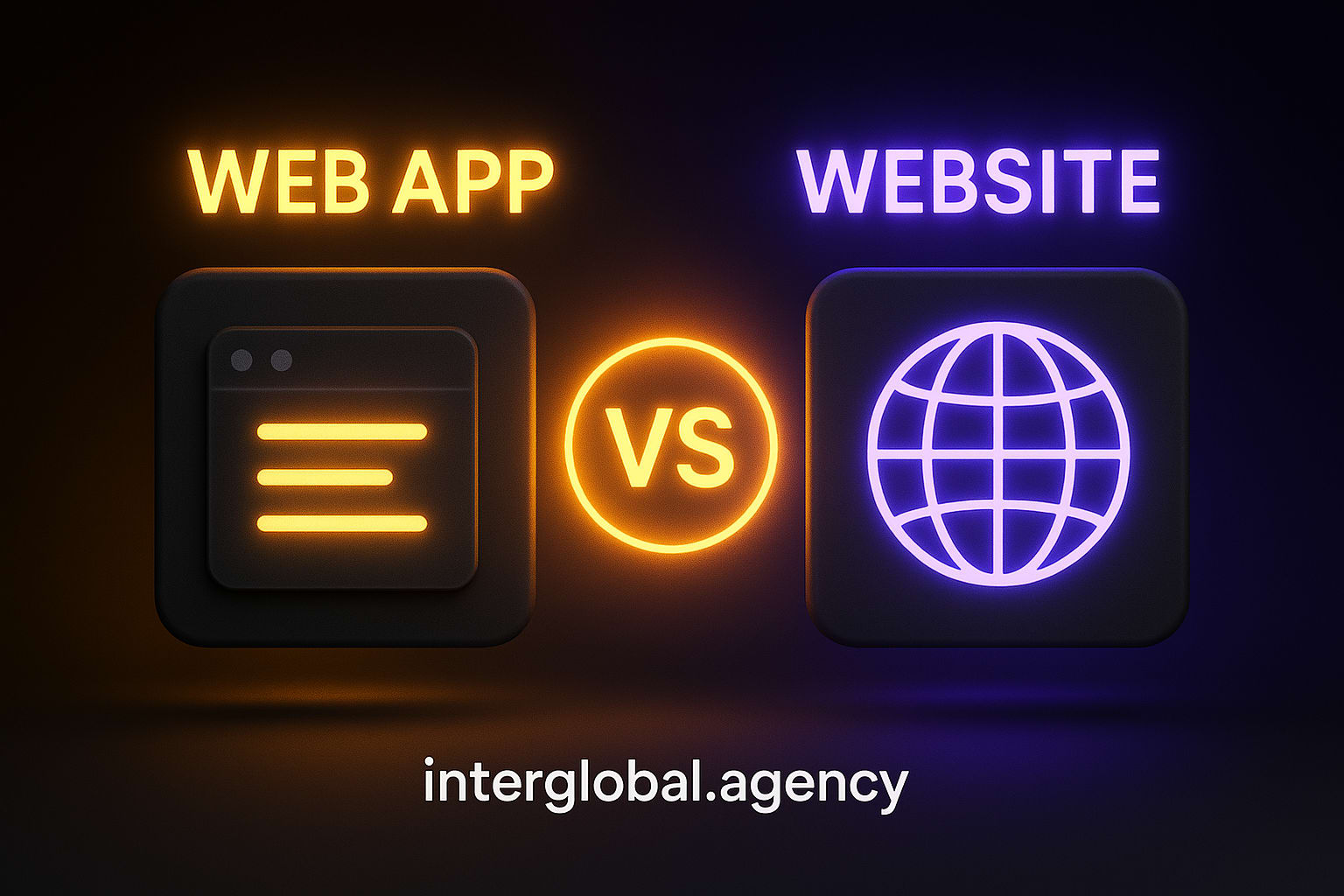
Web Applications vs Websites: What are the Key Differences?
You’ve probably heard people use the terms website and web application (web app) like they mean the same thing. But they don’t. And if you’re planning to build something online, this will help to understand what each one really is.
A website is mostly informational. Think of it as a digital space that shares details about a business, product, or idea. It usually includes pages like Home, About, Services, Contact, and so on. You read, scroll, click, and get the information you need on each page. That's the main point—it gives you content.
A web application (or web app) is different. It’s built for interaction. Instead of just showing you stuff, it lets you do stuff. Things like signing in, managing a dashboard, editing a file, booking an appointment, or chatting with a bot. A web app responds to your input and gives results based on what you do. It runs in your browser, just like a website, but it's more like a software tool built for the web.
This article breaks down the key differences between the two—how they’re used, how they work, what technology they’re made of, and why you might choose one over the other (or need both).
Table of contents:
- Key differences explained
- Interactivity: How people use it
- Functionality: How it works
- Technology: what kind of technology is used to run it
- Development process: The process used in building it
- Maintenance: the requirements to keep it up and running
- Web apps vs. websites common misconceptions
- Conclusion
- Web app vs website FAQ
- What is the difference between a web app and a website?
- Can a website become a web application?
- Is a website always the simpler option?
Have a project in mind?
Let’s Make It Happen!

1. Interactivity: how people use it
Websites are mostly “read-only”. You visit, scroll through content, click on some links, maybe fill a contact form and that’s about it. Interaction is limited.]
Web apps are built around interaction. Users log in, input data, customize features, make changes, and get dynamic responses. The whole point is that the app responds based on what users do.
Example: A bakery website might just show you their menu details and contact info. A bakery web app lets you create an account, customize your order, select pickup time, and make payments.
2. Functionality: how it works
Standard website functionality is largely limited to links in the navigation menu that allow visitors to jump to the site’s various web pages. The web browser scrollbar allows them to move up and down longer pages.
The goal is to present content that users can browse or consume passively. There may be some elements that encourage limited interaction like signup forms or media players, but these don’t allow users to enter or manipulate data for the purpose of running tasks or solving problems.
A web application, on the other hand, can offer any type of simple or complex functionality, allowing users to perform actions similar to what they might do with desktop software or mobile applications.
For example, users can make an online purchase with a calculated shipping fee, enter and manage income and expenses data for a tax return, or send, receive, and sort communications with co-workers in various departments of a large organization.
3. Technology: what kind of technology is used
Web designers can build entire websites using just the most basic web development technology. Hypertext markup language (HTML) is used to format page content, and cascading style sheet code (CSS) is used to define page layouts and the overall design.
JavaScript can also be used to add more dynamic features, such as animations or form validation, and PHP can be used to store and retrieve content from a database.
A content management system (CMS) like WordPress or a no-code website builder offers a simple way to manage a website without editing code.
In many cases, static websites can be hosted on simple web servers with minimal resources. Resource levels can then be increased as web traffic increases.
Web app development, while still reliant on HTML, CSS, and JavaScript, requires a more sophisticated technology stack.
Advanced JavaScript frameworks like React, Angular, and Vue improve functionality so users can interact with an app on a web page without having to reload it.
Web apps typically require server-side processing, so they use back-end technologies like Node.js, Ruby on Rails, or Django to handle requests and process user interactions.
While WordPress blogs store text content and settings info in databases, the database management system (DBMS) for a web app should provide more secure authentication mechanisms to protect user data and prevent unauthorized access.
While this technology stack may seem overwhelming, there are web application development tools that can help simplify the process.
Hostinger Horizons can bring your web app ideas online without learning coding languages or configuring a server. It can choose, provide, and configure all the necessary technologies to build a fully functional web app.
Simply describe the features you want by typing prompts. Then, once you’re happy with your new web application, simply click a button to launch it. It will be live on the web in minutes.
It’s available risk-free with a 30-day money-back guarantee.
4. Development: the process used to build it
Building a website is usually faster and simpler. It’s more about designing the look and organizing the information you want to use on it.
Web apps, on the other hand, require planning around user roles, data handling, permissions, authentication, testing, and more.
Web development projects can often be handled by a small team. Web app development usually needs multiple developers, including UI designers with front-end and back-end specialists.
5. Maintenance: the requirements to keep it running
Website maintenance involves posting and editing text, uploading images, and adding any other media that will be of interest to your site visitors.
Ecommerce or CMS-based websites will require back-end maintenance, such as updating plugins and themes, but these tasks can often be automated. It may also include managing server software to ensure consistent site performance, and keeping security tools and settings up to date.
Maintaining a web application, in addition to performance monitoring and security updates, requires continuous attention to ensure the app remains functional and compatible with dependent technologies.
Back-end systems, such as databases, user authentication, and integrations with third-party APIs, require regular attention to ensure that all components are running smoothly and securely.
Web application maintenance tends to be more extensive than website maintenance due to the technical demands of handling user data, increased interactivity, and more complex back-end systems.
Think of websites as a billboard you update sometimes. Web apps are like machines that needs regular checks to keep working.
Have a project in mind?
Let’s Make It Happen!
Web Apps vs. Websites: Common Misconceptions
1. “A website is just a simpler web app.”
Not always. A website and a web app serve different purposes. A website is designed to inform, while a web app is built to perform. Just because one looks simpler doesn’t mean it’s part of the other. Some websites are complex, and some web apps are minimal. The goal is what sets them apart.
2. “Web apps are always better than websites.”
Better for what? If your goal is to share company info or publish articles, a website is perfect. A web app is better when you want users to do something—like register, interact, or manage data. It’s not about which is better; it’s about what fits your needs.
3. “If it’s interactive, it must be a web app.”
Even websites can have interactive elements like forms, videos, and animations. That doesn’t make them web apps. A web app goes deeper: it lets users make changes, store data, and personalize their experience.
4. “You always need a web app if you want a login feature.”
Not true. Many websites offer user logins just for access control like downloading resources or joining a newsletter list. That doesn’t make them full web apps. A login alone doesn’t define a platform as a web app. What matters is what happens after you log in.
5. “Web apps are always more expensive.”
Web apps can cost more due to their complexity, but not always. With the right tools and a clear scope, you can build a light web app affordably. On the flip side, a highly customized website with animations and SEO features can also be pricey. It depends on what you need.
6: Web applications can also be mobile applications
Web applications and mobile applications are different in how they’re built, deployed, and accessed. Web apps run in a web browser and can often be viewed on mobile devices, but they are not installed on mobile devices, except they’re “PROGRESSIVE WEB APPLICATIONS” which can be installed directly from the browser. Mobile apps require installation from app stores, and separate versions must be developed for specific operating systems like iOS or Android.
Some web applications can be converted into progressive web apps (PWAs) to function similarly to mobile apps, but they’re still distinct from native mobile applications.
Websites and web applications always require internet access
Most websites rely on internet access to fetch and display content from a web server, but once the content is displayed on the page and cached in the browser, it typically doesn’t require a connection to the web until the user clicks to navigate to another page or clicks to stream media content.
Most web applications generally do require a connection to the internet to function, although some elements may work without needing to connect to the server.
Progressive web apps can often function offline or with intermittent internet access. PWAs use caching techniques and service workers to store data on the device, allowing the app to continue working without a continuous internet connection.
These technologies enable PWAs and some other web applications to offer offline functionality, syncing data once the user is back online.
Conclusion
Although both are delivered and viewed via web browsers, websites and web applications serve distinct purposes. Websites are designed to inform, delivering mostly static content for users to read and explore passively. In contrast, web apps are built to enable, providing users with tools to perform tasks, manage data, and interact. Developing a website is often simpler, especially if you use a CMS or a website builder. Meanwhile, web app development can be more demanding due to the advanced technologies and infrastructure required. Hostinger Horizons simplifies web application development and deployment without sacrificing functionality. You can build and launch a web app in minutes without extensive coding skills, giving you more time to focus on your business.
Web app vs website FAQ
What is the difference between a web app and a website?
A website is designed to display content, while a web app focuses on user interaction and task completion. Websites are typically static or minimally interactive, whereas web apps offer dynamic features, process user input, and often require back-end systems for real-time functionality.
Can a website become a web application?
Yes, a website can be a web application by adding task-oriented functionality. For example, a simple restaurant website can evolve into a web application by integrating online reservations, real-time menu updates, and order-tracking features.
Is a website always the simpler option?
No, a website is not always the simpler option. Websites are generally simpler in terms of their design and functionality, but it really depends on what you’re trying to achieve. A web application becomes the better choice if your project requires personalized user interaction and data processing. All of the tutorial content on this webs

Michael Ibeh
Author
A tech-driven digital expert with interests in Artificial Intelligence and Web development delivering premium services for businesses worldwide.


